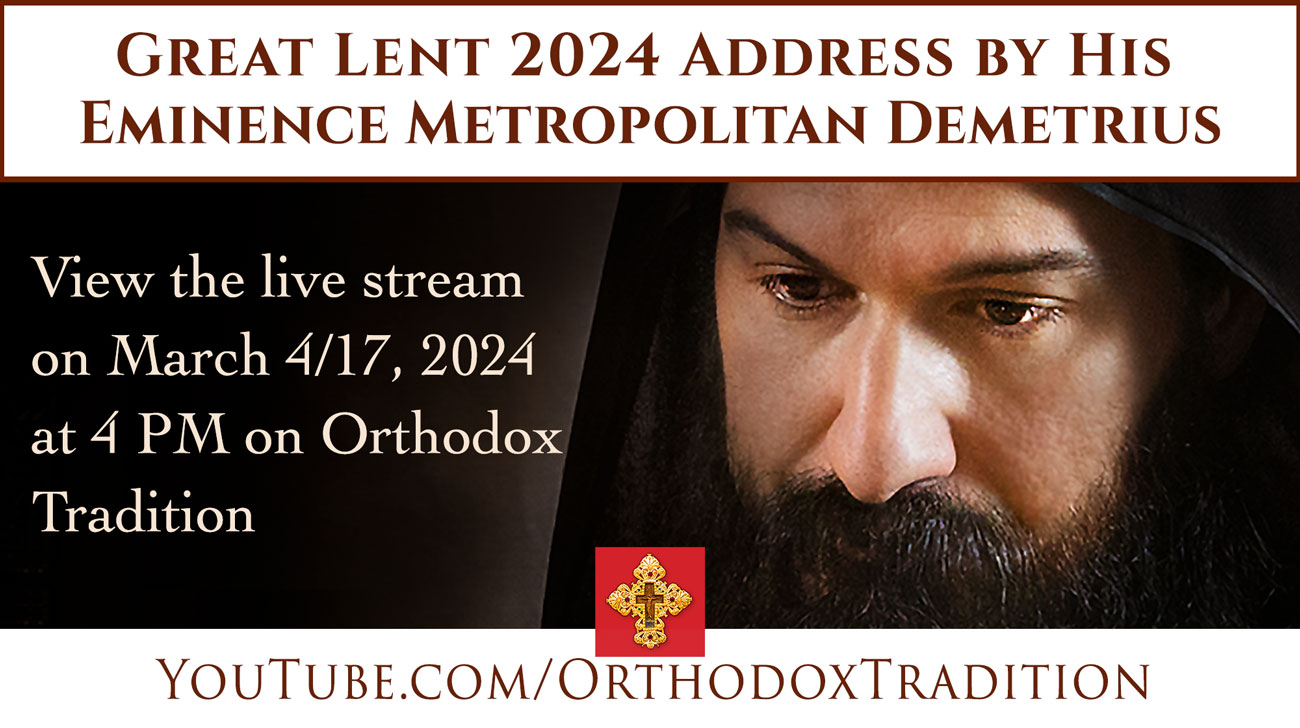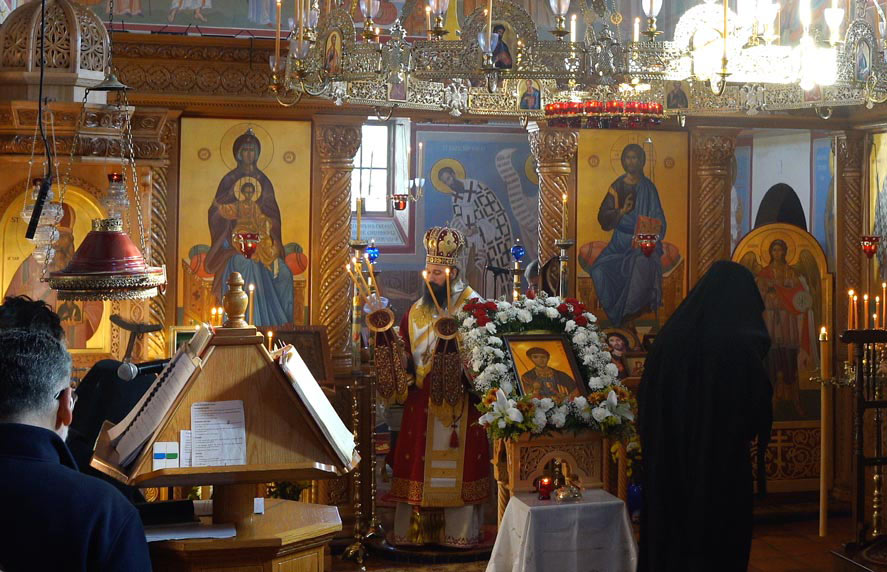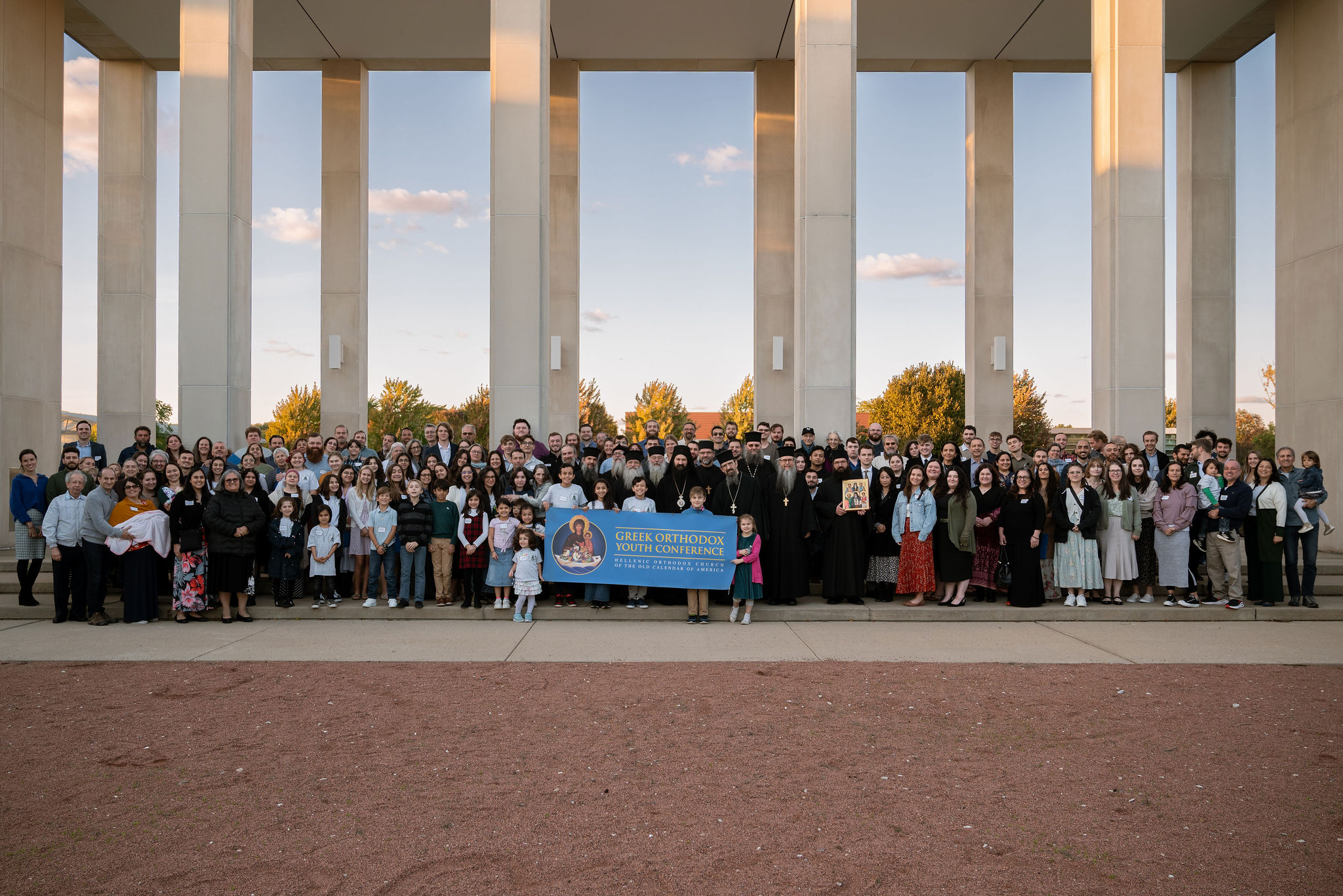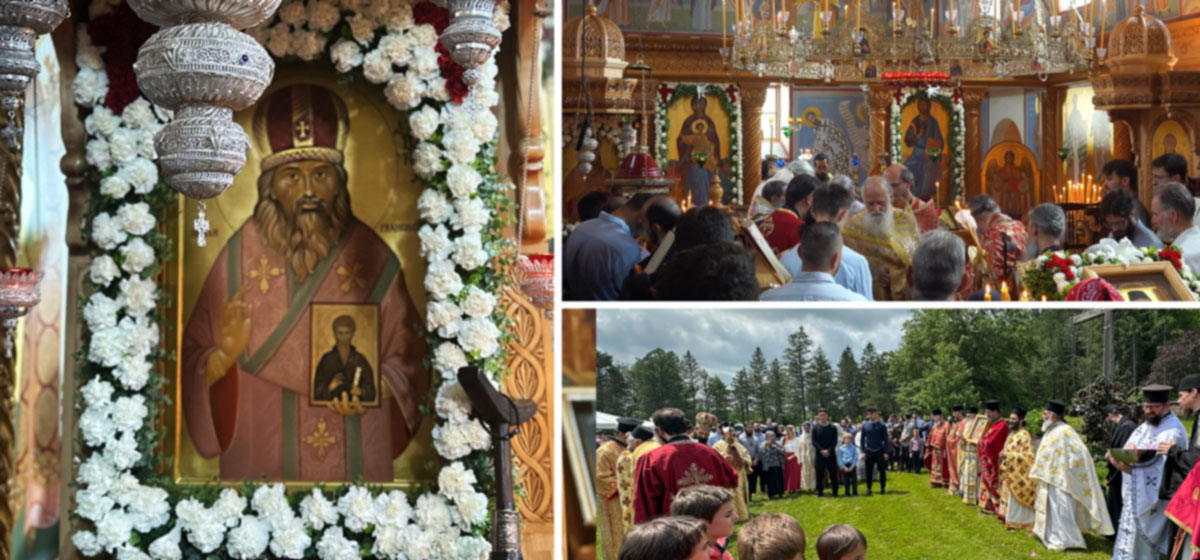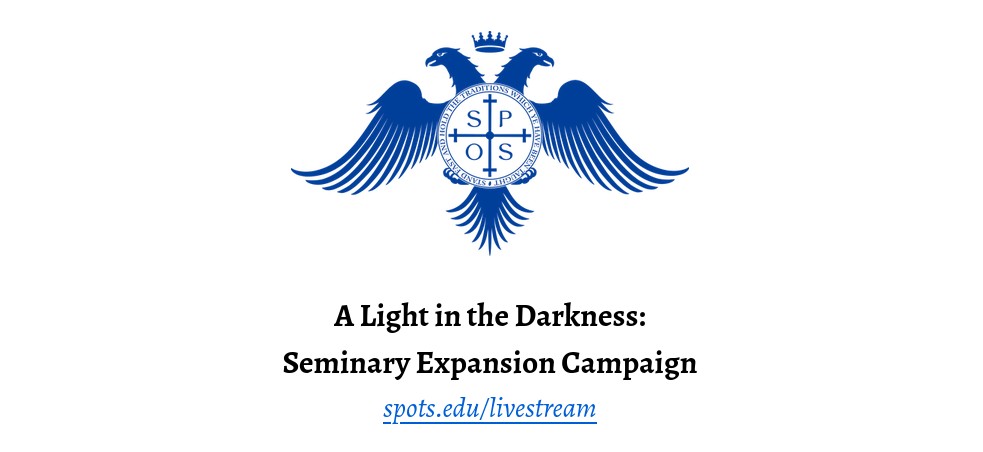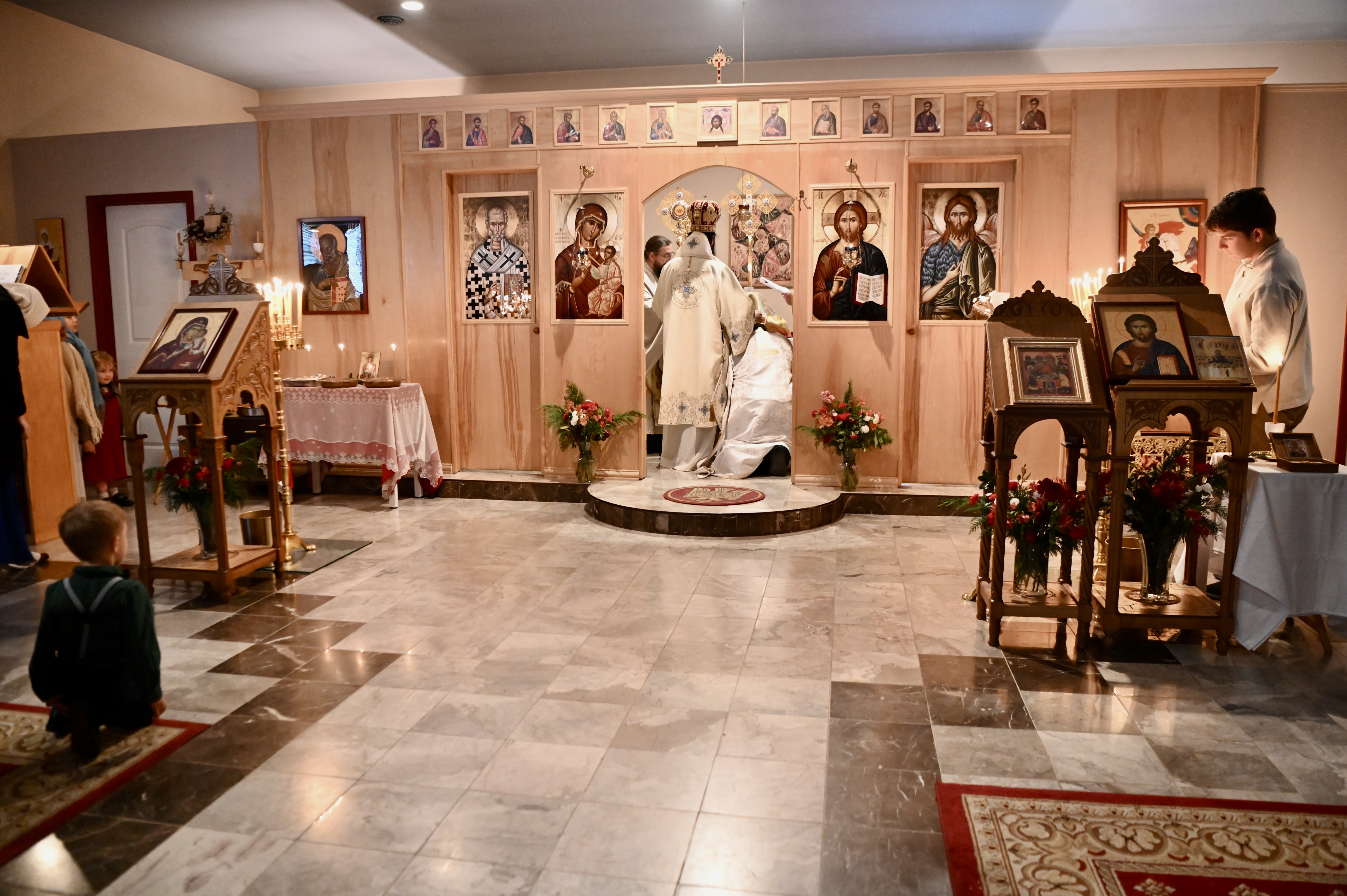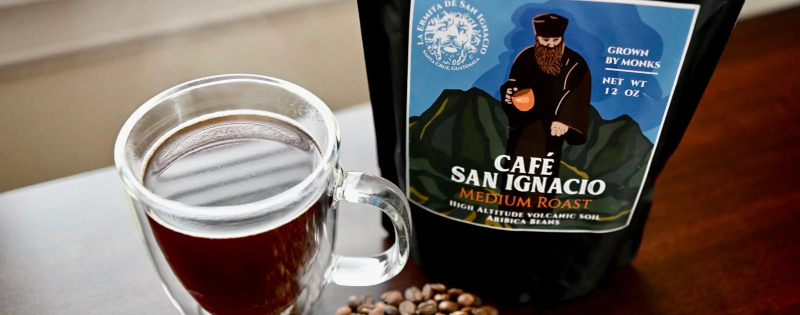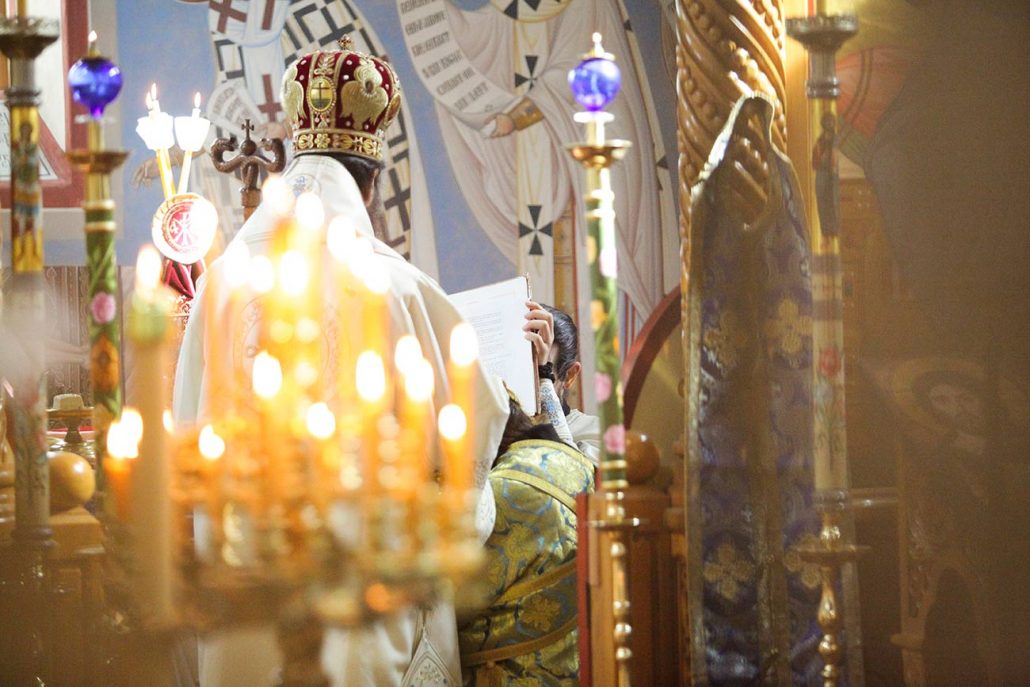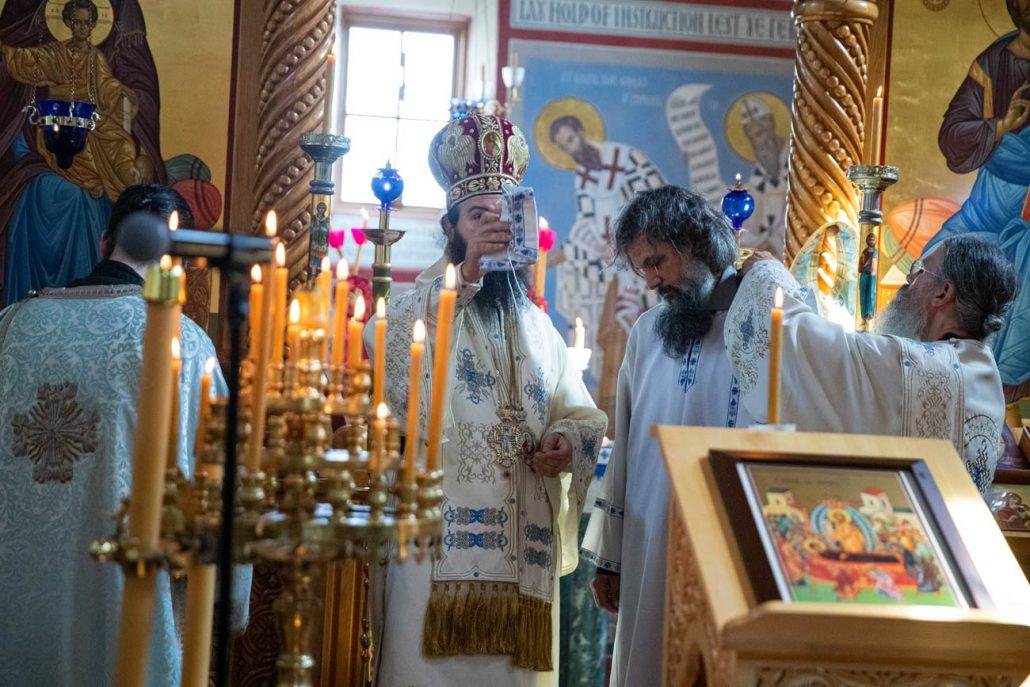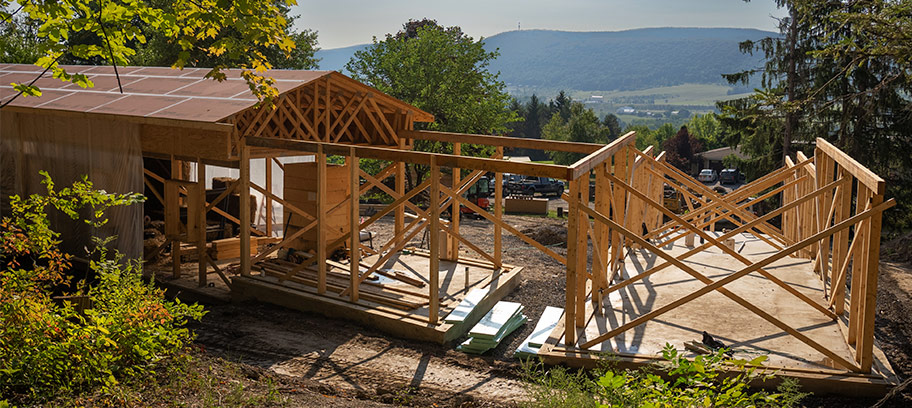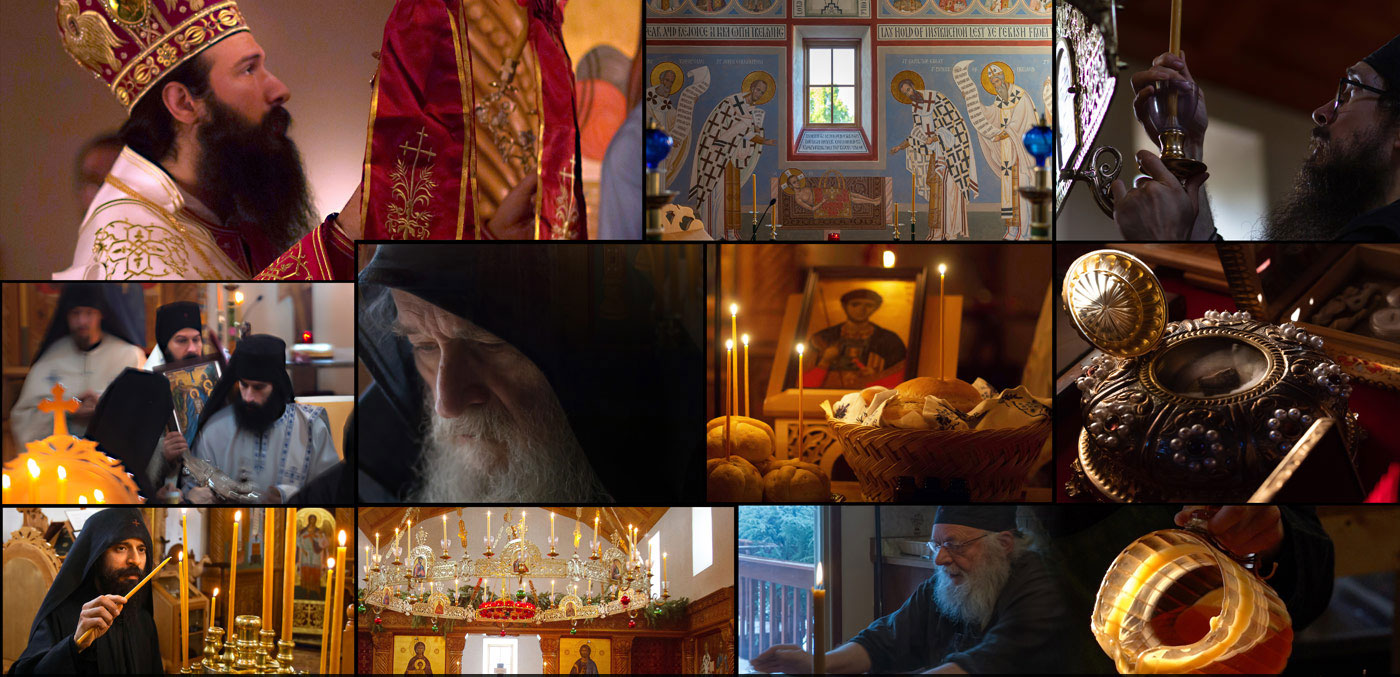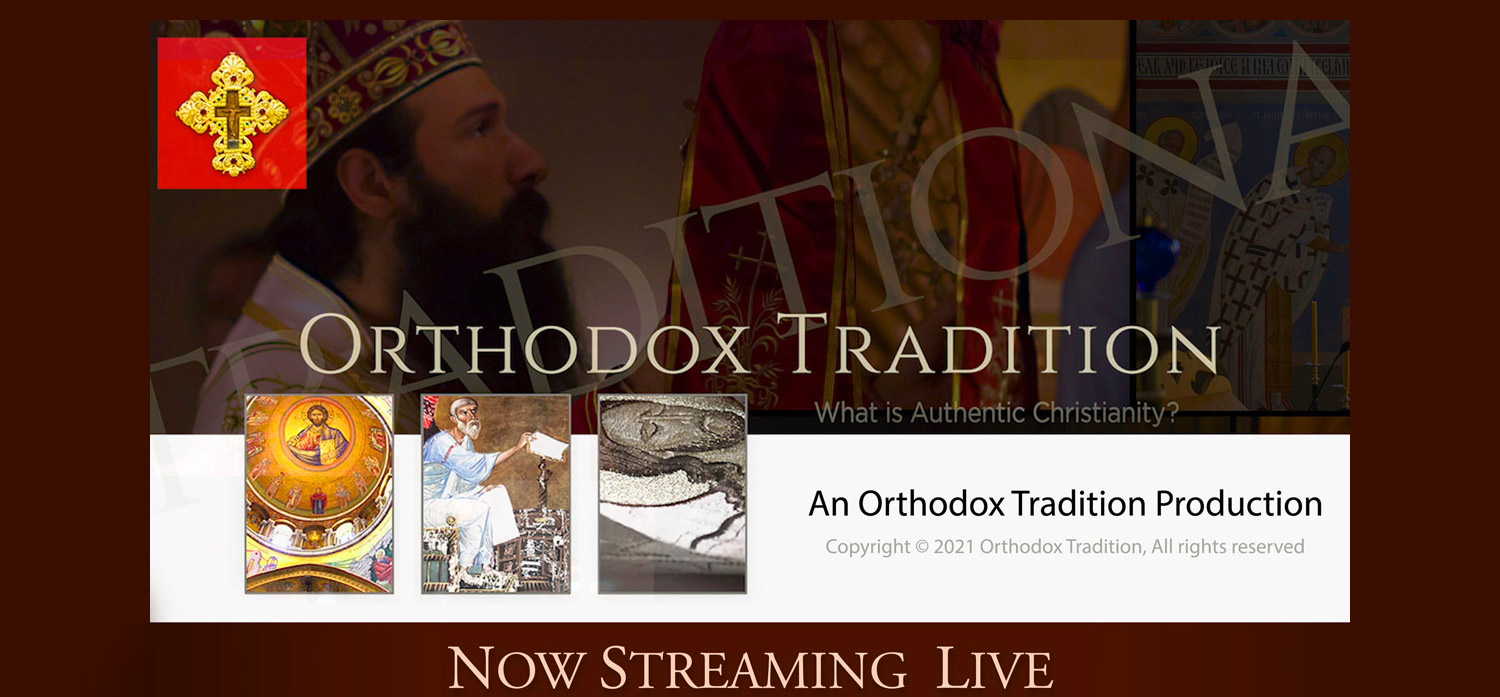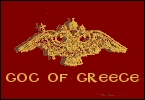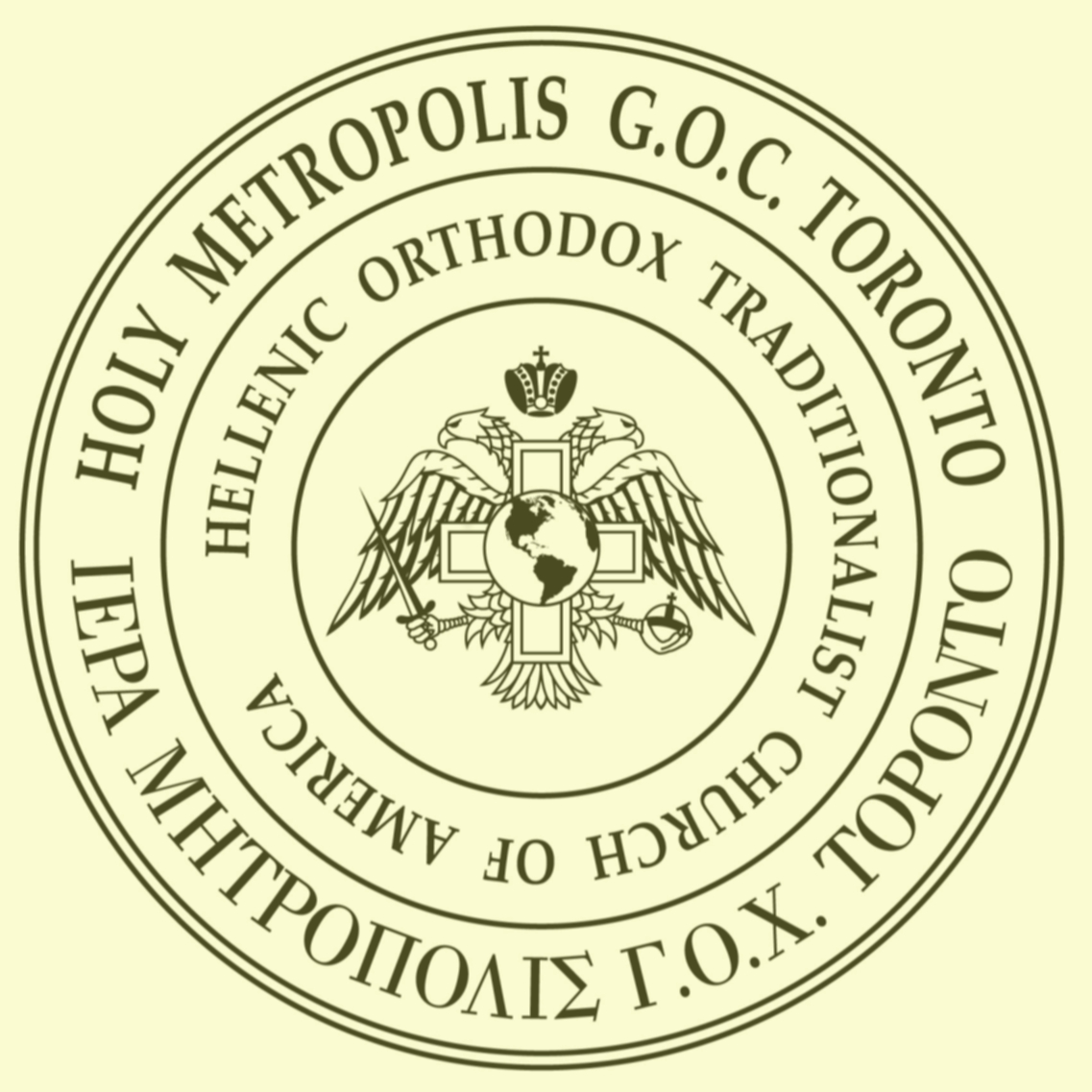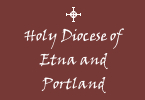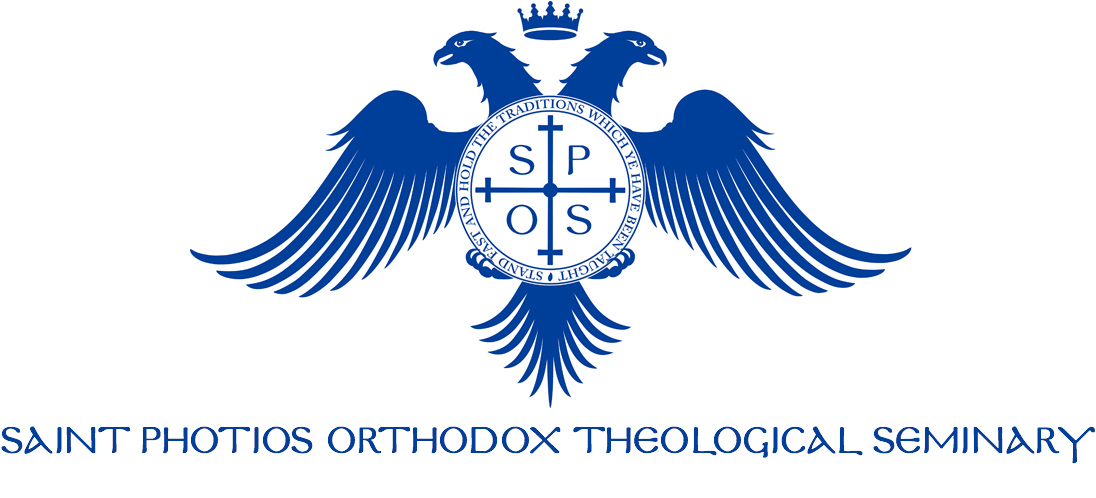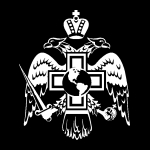The Spiritual Watch
Below, please find the latest issue of The Spiritual Watch, the official publication of the Metropolis of America, published with the blessings of His Eminence, Metropolitan Demetrius of America. In The Spiritual Watch, you will find news and information regarding our Holy Metropolis, as well as spiritual writings.
The Spiritual Watch, Vol VII (New: February 24/March 8, 2024)
Quote From the Fathers
I shall speak first about control of the stomach, the opposite to gluttony, and about how to fast and what and how much to eat. I shall say nothing on my own account, but only what I have received from the Holy Fathers. They have not given us only a single rule for fasting or a single standard and measure for eating, because not everyone has the same strength; age, illness or delicacy of body create differences. But they have given us all a single goal: to avoid over-eating and the filling of our bellies... A clear rule for self-control handed down by the Fathers is this: stop eating while still hungry and do not continue until you are satisfied.
—St. John Cassian, On the Eight Vices.
About the Fast
The feast of the Resurrection, Pascha, is the most important feast of the liturgical year. In order to prepare for this great day, the Church has appointed a time of fasting and preparation, which is called Great Lent. Great Lent begins on Clean Monday (March 5/18 this year), and lasts 40 days. After the 40 days, we begin Holy Week with the Feast of the Raising of Lazarus and Palm Sunday.
There are five Sundays during Lent:
- Sunday of Orthodoxy
- St. Gregory Palamas
- The Holy Cross
- St. John of the Ladder
- St. Mary of Egypt
In addition, there are multiple other commemorations that the Church has arranged for our spiritual edification.
How Do I Fast?
If you are new to fasting, or are not sure you have been doing it properly, know that the first step is to find an experienced spiritual father; a priest or monk of our Eparchy, or of one of the monasteries or parishes of our Church in Greece. Fasting is not a discipline that can be self-directed, and should be part of a balanced spiritual life including attendance at the Divine Services, private prayer at home, acts of charity, and the reading of Holy Scripture.
The general rules of Lent are simple; Monday through Friday are a strict fast, when we refrain from meat, dairy, fish, olive oil, and wine. Saturday and Sunday we are permitted wine and oil. On Annunciation, we are permitted fish.
If you are elderly, very young, sickly, or new to fasting, your spiritual father may give you a rule of fasting that is less strict than that which is described here. This is because fasting is not a set of rules and regulations, but a spiritual medicine that the spiritual father, as your spiritual doctor, determines will be for your benefit, taking in to account your state in life. We should refrain from judging those who do not fast as strictly as we do, while praying that they will grow in strength to do so.
In addition, there are extra services such as the Presanctified Liturgy and the Salutations that are prayed during the weekdays of Lent, and we should make every effort to attend these.
Fasting will be of no benefit to us, however, if we do not love our neighbors more than ourselves. Fasting is a tool in our arsenal against the Evil One, but it is useless if we bite the head off of our brother.
If you are living far away from a Church and cannot attend the services during Lent, contact our missions department below for advice on how to participate as best as you can. Spiritual growth is open to you even if you live a great distance.
Finally, dear readers, we pray that you will include us in your prayers, those who prepare this site for you, that we will remain firm, crossing the Sea of the Fast, and arriving at Pascha prepared.
Icon of Christ is © Holy Transfiguration Monastery, and used by permission.
Traditional Faith Perseveres
- Details
- Created on Wednesday, 29 September 2010 16:21
Jewel on the Side Streets of New York
On a quiet, tree-lined street in the Astoria district of New York City, the mysterious shapes of giant steel domes appear, piercing through the monotony of flat tarred roofs with their soft, round shapes evoking in the passer-by images of the Middle East and the glory that was Byzantium. The quiet greenery of that street belies its proximity to the hustle-bustle of the Manhattan skyscrapers just a “stone’s throw” across the river. The stillness is only broken by the occasional sound of an Amtrak train passing overhead on its aqueduct shaped bridge.
The Immigrant Foundations
Before reconstruction of the new building began, there stood a little house-church which had for 30- years served as home to a pious portion of the Greek Orthodox community. Like the Pilgrim Fathers in Massachusetts, these particular Greeks had come to America to find religious freedom in the face of fierce, often violent, persecution of their faith in Greece. Ironically, they are not members of a small sect. By a quirk of history the government of Greece, in 1924, outlawed the 2,000-year old traditional Orthodox church in favour of a modernized Greek Orthodox State Church. Anyone opposing the beliefs of the State Church was branded as “uncanonical,” and “schismatic” and—as the persecution reached a pitched fervour in the 1950’s—the traditionalists were condemned in the secular Greek press as “enemies of the Greek people. . .those who seek to shatter our ethnic unity.” Under the leadership of monks from Mount Athos the traditionalists, or “Old Calendarists” as they were labeled by the modernists, went underground in Greece until a recent revision of the law allowed them to publicly exercise their religious preference.
The First Priest
One such Athonite monk was sent to America to assist the emigrant believers. In 1952, Father Petros Astyfides, from St. Anne's Skete, settled in New York and began serving Divine Liturgy at the Old Calendarist Cathedral of St. Nicholas (near the WTC). In 1954 he started services for a small flock in a house-church on 26th Street in the Astoria district. He was latter joined by a deacon and some nuns from Greece who helped to establish a Greek school. With the passage of time, the small community was able to acquire several attached homes on the block which became a church, rectory, monastery, convent, and classrooms. The whole thing was named for a child-martyr, Saint Markella of the island of Chios.
Growth of a National Archdiocese
In other cities of the U.S. other traditionalist churches were coming into existence as well. Eventually Fr. Petros was ordained to the episcopate and became Bishop of Astoria. He was appointed “Exarch of America” by the Holy Synod in Greece to serve the traditionalist communities all over the country. The little house-church in Astoria had become a cathedral—de facto—and the national center of the traditionalist “Old Calendar” Greek Orthodox in America (the State Church also has its own headquarters in Manhattan.) On the national level the diocese continued to grow—churches and schools, a radio program in Florida, a TV program on Greek cable, newspapers—even a small convent on Long Island were established. At the same time, the congregation in Astoria was “bursting the walls” of the old cathedral, the diocesan offices were in the attic, the school in the basement.
Finally, necessity forced the issue. It was decided to build a new cathedral. The style, of course, had to be traditional. The building needed to be large, but the desire was to preserve the atmosphere which the small old church had had.
The Model: St. Saviour in Chora (Constantinople)
The inspiration for the design of the new cathedral was taken from the Church of the Saviour in Hora. This Byzantine church was originally built as monastery “in the Country-side” (Chora) just outside the walls of Constantinople. The Roman Emperor Constantine the Great had resolved to move the Imperial Capitol from Old Rome on the Tiber (with its pagan legacy chiseled on the walls of its temples) to a “New” Rome which he had built on the Bosporus. Constantine’s new city (Constantinople) was built throughout with Christian churches and monasteries. The Church in Chora was one of them.
Prayer Complicates Engineering
Prior to commencing the new church in New York, a daily cycle of services had been running without interruption for nearly thirty years. When construction began, it was decided that the services must not be halted. Thus, the project became complex for the engineers as they had to build the new church around, over, and under the old one. Only when the new building was capable of being used for services was the old structure demolished and removed from the interior of the new one.
Church Built By The Poor
The political strictures imposed upon the traditional believers in Greece led many to aceed to the will of the State Church, some for economic reasons, others for fear of consequences to their children. Thus it is that members of the traditional church are often from the lower economic strata. These are the people who built the new cathedral. The engineering complications caused the construction time and cost to double, so that the basic steel and cement structure cost over $2 million when finally completed. The iconography, carved veneration-stands, chandeliers, episcopal throne, carved chairs, standing candelabras, and interior finishing work and the rest of what constitutes a traditional “Byzantine” style Greek Orthodox Church ended up costing millions. But, to the average member of the Church, it is well worth it. “For my kid’s sake, I gotta do it” says one old woman in New York. “Hey, we’re in America now, a free country,” says a man in Detroit, “the cathedral is our national center—it has to be a symbol of our faith we can look to.” One priest in Chicago said, “The Cathedral is the mother church of our diocese. We hope that it will continue to be productive in the salvation of souls, so that—according to God’s will—her daughters (our parish churches) will prosper spiritually from her spiritual success.”
Fire Strikes
In July of 1995, when the Cathedral was nearly completed, the Cathedral suffered from a serious fire. The fire started in the altar and did much damage there though the clergy were able to get the Holy objects out of harm’s way. The iconostasis was completely destroyed and all the icons thereupon were seriously damaged or completely consumed by the flames and immense heat. No trace of several of them was ever found. A large brass free-standing candleabra was completely melted away, no trace of it was ever found.
After the firemen left, the clergy noticed that sitting face-up on the mass of burnt and water-damaged rubble was the icon of St. Markella. The icon was completely undamaged. The backing that the icon was mounted on was charred black though the icon itself and all the precious offerings hanging on it were untouched. The Old Calendar believers struggled to raise the funds to repair the Cathedral and today the results speak for themselves. There is a new carved iconostasis, a new marble floor, several new free-standing brass oil-lamp stands an immense polyeleos (Chandelier), and several smaller ones. There is a new carved episcopal throne, several carved veneration-stands, hundreds of carved chairs, and two new candle-selling stands (pangaria) and carved sand-boxes. The Cathedral is currently seeking donations to pay for these beautiful and traditional items.
Bishop Petros Reposes
In 1997, after struggling to preserve the Genuine Orthodox Faith for his entire life, Metropolitan Petros reposed in the Lord. Geronda Petros suffered greatly at the hands of the “official church” for his adherence to Genuine Greek Orthodoxy. He never wavered in his belief and confession of the Genuine Orthodox Faith. It is the same confession of the Holy Fathers and the same confession of all Old Calendarists.
In 1998 the Holy Synod of the Genuine Greek Orthodox Church of Greece elevated the Archdiocese of Astoria to the Holy Metropolis of North and South America. This was done in conjunction with the consecration of Archimandrite Pavlos of Astoria to the Episcopacy with the rank of Metropolitan of North and South America.
Latest News
- His Grace Bishop Benedict of Astoria Ordained Bishop
- ΑΝΑΚΟΙΝΩΣΗ: ΧΕΙΡΟΤΟΝΙΑ ΤΟΥ ΘΕΟΦΙΛΕΣΤΑΤΟΥ ΒΕΝΕΔΙΚΤΟΥ ΕΜΨΗΦΙΣΜΕΝΟΥ ΕΠΙΣΚΟΠΟΥ ΑΣΤΟΡΙΑΣ
- Announcement: The Ordination of His Grace Bishop-elect Benedict of Astoria
- Deacon Andrew Wales Ordained a Priest
- 2023 Parish Contributions
- Feast of the Holy Great-Martyr Demetrius at Saint John of San Francisco Orthodox Monastery
- Youth Conference 2023 Photos
- Hierarchical Concelebrations, Synodal Meeting, and Clergy Conference
Latest Content
- Prayer & Fasting (Sermon)
- Stop Daydreaming; We Have a True Mother (Sermon)
- Metropolitan Demetrius's Great Lent 2024 Address
- Have You Ever Thought That You Might Go to Hell? (Sermon)
- New World Order, Conspiracy Theories, and the Solution (Sermon)
- Christ Is Not the Cause of Your Fall (Sermon)
- Zacchaeus, The Signs of Demonic Influence, and Self-Pity
- Saint Xenia & Contemporary Fools for Christ (Sermon)
About the Church
The Church of the Genuine Orthodox Christians (GOC) of America is The Traditionalist Orthodox Church serving the faithful of North and South America following the old (Julian) calendar. Having its roots in the Diocese of Astoria, founded by Metropolitan Petros (Astyfides) in 1954, it presently consists of two Metropolises (America and Toronto) and two dioceses (Etna and Portland, and Boston), shepherded by five hierarchs, under the Presidency of His Eminence, Metropolitan Demetrius of America.
The Church of the GOC of America is an autonomous Eparchy whose Mother Church is The Holy Synod of the Church of the GOC of Greece, under the Presidency of His Beatitude Archbishop Kallinikos of Athens and All Greece. The bishops belonging to the Eparchial Synod are also members of the Holy Synod of the Church of Greece. We resist the heresy of Ecumenism.
Orthodox Awareness
Why the True Orthodox Are Truly Orthodox
A Rejoinder to Fr. Basil Gregoriates and an Apology for Breaking Communion with Ecumenist Bishops
In every age the devil tempts the faithful by various means: persecutions, foreign invasions, the lure of worldly seduction. Among his most effective snares are heresy and schism which, by separating Christians from the Church, lead them away from Christ and into spiritual deception and apostasy. Read more...
Missions
Saint Matthew the Evangelist, Jonesboro, Arkansas
Jonesboro is a town located near the Eastern border of Arkansas, with a population of approximately 60,000. From a human standpoint, it’s not the most likely candidate for a traditional Orthodox mission, but for an Orthodox Christian who orders his priorities around Christ and His Church, it makes perfect sense. Read more...
Youth
2023 Youth Conference
Please join us for the 2023 youth conference in Chicago, IL! To learn more, visit the home page or visit the conference website.
Ask A Priest
Fasting
Q. There seems to be a lot of variation in how people observe fasting, but my confessor told me to fast from oil on Wednesday and Friday. Oil is a pretty vague category, though, and I was wondering if I could get a more explicit description of what kinds of food and drink are excluded on strict fast days. Read more...
